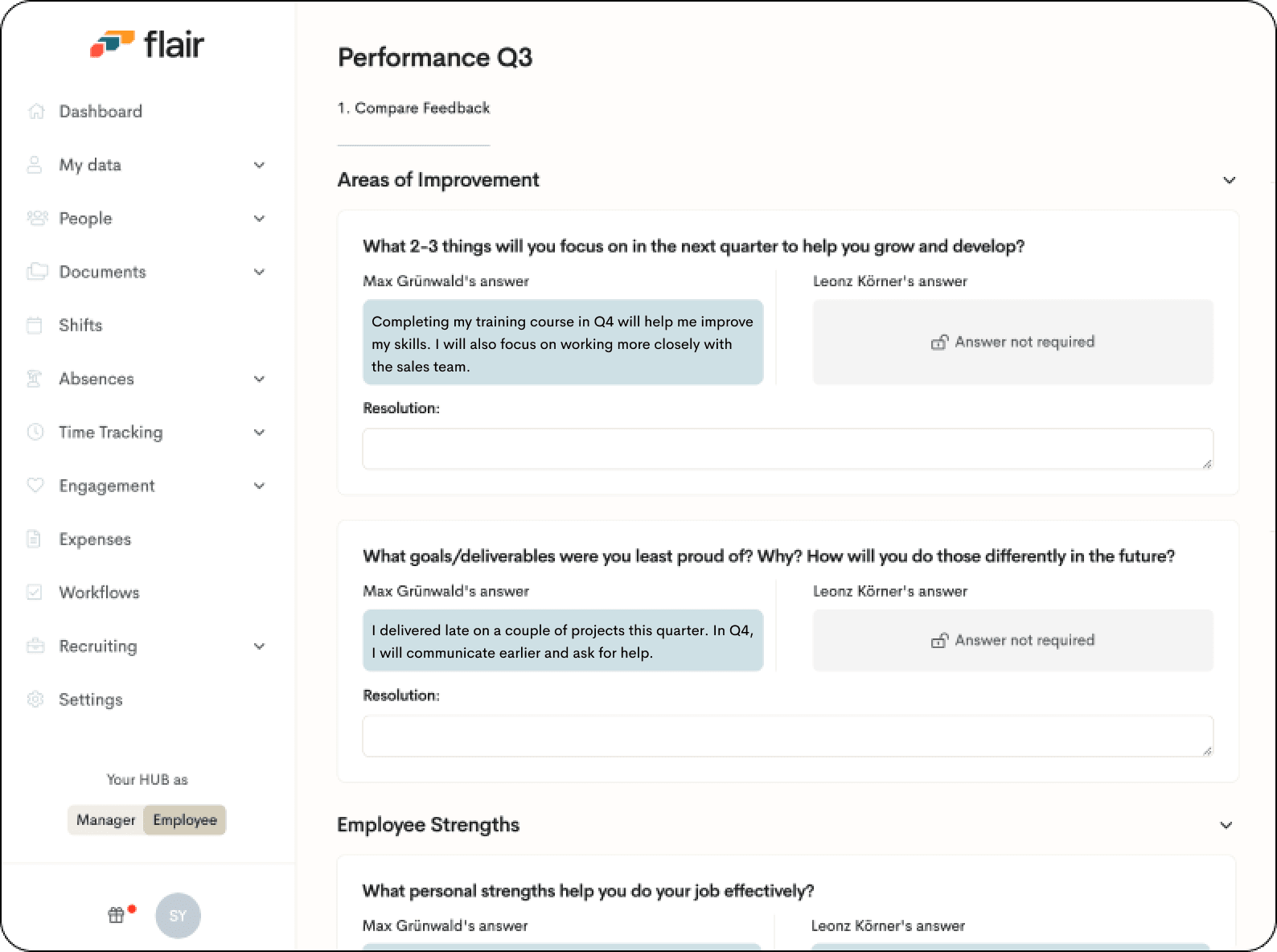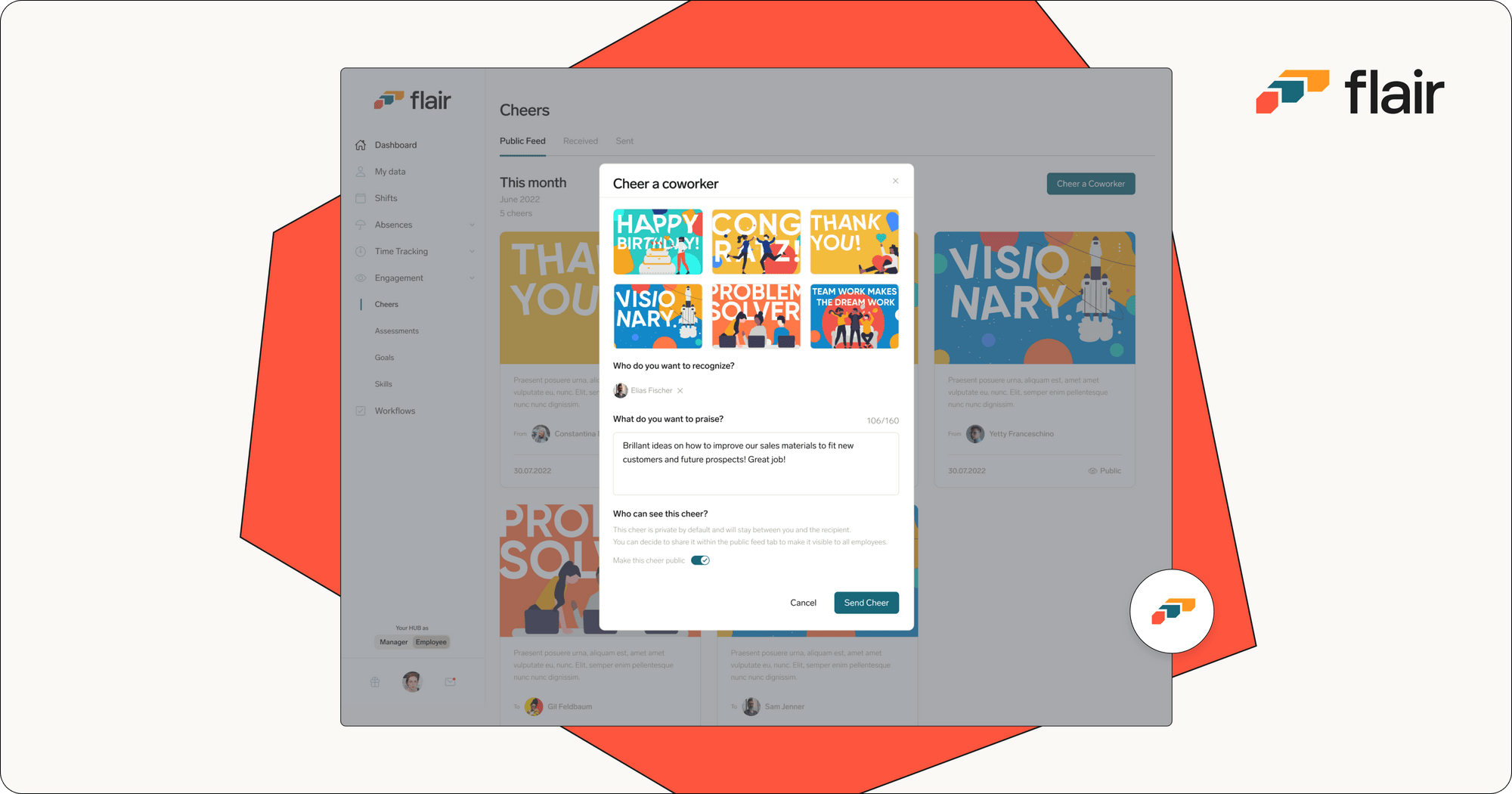Millennials – Understanding the Way They Work
Millennials make up the majority of the workforce today. How can you attract and retain the best millennial talents? And is it time to rethink some of the stereotypes?
- 20 Jun 2024
- Max 9 min read
The Number One HR Solution on Salesforce
Employee engagement is a tough nut to crack – especially given the fact that it can vary from company to company and person to person. Nevertheless, there are a few important factors that every employee engagement strategy should consider.
There are different ways to define and measure employee engagement. You can learn more about the definition of employee engagement in this article.
It is generally agreed that there is no one-size-fits-all strategy for employee engagement. Initiatives that lead to more engaged employees in one organization might fail in another. It all comes down to the company culture and how much each individual values certain ways of working. For instance, while one person might prefer flexibility, another might rather stick to a routine. While autonomy is really important to some, others may work better with detailed instructions.
So while there are no universal guidelines, we’ll take a look below at some employee engagement best practices that can enhance workforce productivity and employee retention. First, let’s take a look at the relationships that influence engagement.
One of the most important factors of employee engagement is how employees work with each other. Collaboration is crucial. When employees feel a strong connection with their coworkers, they become more motivated and are likely to produce better results.
Employees with positive attitudes often improve the mood of their coworkers, too. However, negative attitudes often have the opposite effect. If something isn't going the way it was intended, try thinking of ways for employees to share what they’ve learned and build on it – effectively turning a negative into a positive.
While it is difficult to directly influence the relationships between employees, you can foster a collaborative and positive workplace culture through various initiatives. For example, try to introduce meeting formats that bring together employees from various teams. Make sure team leaders act as role models for your employees. And check that new employees are a good cultural fit.
Managers should lead by example. Having an open-door policy and fostering a company culture where employees feel they can approach managers with questions and honest feedback is a huge driver in motivation and employee engagement levels. Not only can employee feedback be extremely valuable for an organization but acting on it will make employees feel more valued and engaged.
As a first step, managers should take more time to listen to employees and understand any concerns they may have. They can then identify the causes of disengaged employees and work on ways to remedy them. More on that later in this article.
Feedback should always be honest. When giving negative feedback, it’s vital to approach the topic carefully and always be constructive. At the same time, you should give employees affirmation when they perform well and acknowledge hard work.

To create a positive and lasting employee-company relationship, help new hires understand your company’s mission during the onboarding process. All employees should be able to identify with your core values – this will help keep them engaged in the long term.
Companies should also encourage professional development both in the workplace and outside of it. Offering to subsidize relevant training courses can be a huge incentive for employees to learn new skills. It strengthens their bond with the company. Having a clear career path also gives employees a stronger sense of purpose and direction.
Embracing change can increase employee engagement. Don't be afraid to try new things in your organization – and give your employees a say in new initiatives. Sometimes they will stick, other times not, but you never know what works best until you give it a go! Employee engagement initiatives will vary for different companies, but they all have the same goal: committed and satisfied employees.
The feeling of having a purpose is an extremely important motivator of people. Within a company, employees should feel their work is meaningful.
A company’s strategy and core values should be clear enough that employees not only understand them but also feel driven by them. Internal communication should regularly convey and reiterate company values so that all employees know what they are aiming for. Doing so creates a stronger emotional connection between employees and the organization, which increases employee engagement.
Of course, organizations must ensure that they actually live up to their own values. When an organization is honest and transparent about its values, it can engage employees in ways that boost productivity and reduce employee turnover.
Line managers have considerable responsibility with regard to engagement. Team leads need the leadership skills to motivate employees and keep them engaged.
At the same time, managers must be fair and empathetic. Employee engagement does not mean hours and hours of unpaid overtime, presenteeism, or a workforce that is afraid of voicing criticism. On the contrary, if employees are overworked or feel like their feedback is unwanted or ignored, they are much more likely to become disengaged. Instead, managers should encourage employees to voice their concerns and allow them to take paid time off when they need it. Team members will return the favor by going the extra mile in their daily work and sharing helpful suggestions.
The team leader’s influence as a role model for the team should not be underestimated. If employees see that their manager looks disinterested or often blames others for mistakes, this negative attitude is likely to spread. However, if a team lead provides a good example, for instance by treating colleagues with respect and taking responsibility, others are likely to follow suit.
Managers should stay close to their team members so they can assess the mood in the team and identify any potential issues at an early stage. Regular check-ins and one-on-ones can help them understand employee well-being. Then, they can take appropriate steps to support individuals or communicate suggestions for improvement to more senior leadership.
Last but not least, managers should live your company’s values. By doing so, they spread these values throughout your organization and reinforce your company culture.
The employee experience comprises everything an employee encounters from their first contact with a company to their last day. It is a very important driver of employee engagement and encompasses everything from your employer brand to office furniture.
To begin with, you need to offer a great candidate experience. This means quickly responding to applicants, clarifying expectations in interviews, and providing fair and constructive assessments of candidates. Doing so might just prove to be the difference between hiring the ideal candidate or missing out to a competitor.
The employee experience continues through onboarding, where you can use software to organize and automate processes. Giving new hires the best start to their time at your company can go a long way to improving employee retention and engagement.
Further down the line, properly offboarding employees when they decide to leave also contributes to the employee experience. Staying professional and parting on good terms is key. After all, why risk ruining a great employee experience right at the very end? Staying appreciative of employees and giving them a nice send-off can lead to more positive employer reviews and word-of-mouth recommendations – potentially helping you find the next top talent.
Your employees are the most direct enabler of engagement. Simply listening to their suggestions and feedback will give you a direct insight into what is working well and what needs to be improved. But not all people are comfortable sharing their feedback with managers – it’s up to you to create an atmosphere where they feel encouraged to speak about how they feel.
HR can act as a mediator – a trusted confidant that represents both the interests of the employees and the company. If HR successfully steps into this role, more employees may feel comfortable enough to come out of their shells and speak their minds.
Another way to obtain valuable feedback from employees is through anonymous questionnaires, such as employee engagement surveys or pulse surveys. By sending out such surveys at regular intervals, you can measure employee engagement levels and see how they develop over time.

When people are looking for a new job, there are many considerations that influence their decision. Employer branding helps create a positive image of your company and attract talent. The goal should be to answer three main questions candidates might have, even before they make contact: What can you offer your candidates, what is working at your company like, and why are you a better employer than others? The answers to these questions provide you with the input you need to create an employee value proposition.
Having a strong employer brand helps you attract employees who are the right cultural fit for your organization. This means they will be engaged from the get-go.
A strong brand has also been shown to increase job satisfaction, as employees can better identify with their company. This results in increased productivity within workplaces.
Changing jobs is a major event in a person’s life. The first couple of weeks at a new company are an exciting time, but can sometimes be overwhelming for some people. A well-structured and engaging onboarding process can relieve a new hire’s nervousness and help them settle in.
Not only does onboarding give employees a better first impression of your company, but it also helps you bring out the best in newcomers in less time. The first few months are a key phase in the employee lifecycle, as it is during this time that employees form opinions about your company and start to feel an emotional connection with it.
Digital onboarding solutions help you automate recurring onboarding processes so that you never miss a step. You can still configure templates for different teams and roles so that employees get a personalized experience. At the same time, regular check-ins with new hires provide the human touch. Encourage newcomers to get to know their colleagues and consider implementing a buddy system to increase engagement at an early stage.
Giving employees regular feedback and recognition is not only a task for managers. Sometimes the most authentic feedback comes from peers. Employees who receive recognition for their work tend to be happier and more engaged.
Your employee recognition program doesn’t necessarily have to include a classic ‘Employee of the Month’ award but can start much simpler. For example, you could create a Slack channel where employees can share praise for a colleague who has helped them out. Or you could use the Cheers feature in flair to send colleagues a thank you message or record a video to show your appreciation.
Attaching tangible rewards to your appreciation adds more value. With Empuls' employee reward system you can disburse rewards for every milestone and achievements.
And it’s not only nice to receive a thank-you message. Encouraging employees to take a moment to reflect on how a colleague has supported them can improve team spirit and strengthen the bond between employees.

Employee referral programs are an excellent way to tap into the network of your top employees. Employees who are generally satisfied with their job are more likely to encourage friends and former colleagues to join your company. This can make life easier for your recruitment team and be a strong lever in attracting the best talent.
You can encourage employees to share your job postings on social networks like Linkedin to boost the reach of your job ads. Providing a nice incentive for successful referrals is an effective way to sweeten the deal and results in a higher referral rate.
While there is no guarantee that referred candidates are the perfect match for your organization, there is a higher chance that they will be. People typically only refer jobs to friends if they are already sure that their friends will enjoy the working culture. And employees who have worked together at a different company are likely to share some skills and personality traits, which can make it easier for them to settle in.
Employees want to improve their skills. Supporting employees in this endeavor is a win-win. Setting aside a budget for training courses and learning new skills is not only an attractive perk for your employees but also expands the skills and knowledge within your organization. This can lead to better results and can make it easier to fill vacancies as you can train your own employees to step up into higher roles. By using a performance management platform, besides keeping everyone aligned with company goals and OKRs, you can also track your employees' progress, identify areas for improvement, and create personalized development plans for each employee.
You should define clear development paths and communicate them to employees. Showing employees what they need to do to get a promotion or a pay rise gives them something to strive toward and motivates them to perform.
Some employers are hesitant about training employees in case they leave in favor of another company. However, by combining the right training opportunities with a clear and fair career path, you give your employees much more reason to stay.
As previously mentioned, it’s important not to confuse engaged employees with overworked employees. An engaged workforce will go the extra mile and will be productive. But that doesn’t mean that someone who does hours and hours of overtime is engaged. They might just have an unrealistic workload, which is a sign of an unhealthy work environment. If left ignored, this could lead to higher employee turnover or even burnout.
Promote a healthy work-life balance and you will benefit from a more engaged workforce. Inform employees about the importance of mental health and point them toward apps and activities that can help them reduce stress. Even using time-tracking software can help as it ensures that employees are taking enough breaks and not working too many hours.
Without a strong team spirit, it is almost impossible to keep employees engaged. Particularly within remote and hybrid teams, it is vital to make sure that everyone feels included.
Team events are the classic way to get everyone together and socialize as a team. But also during ordinary day-to-day work, promoting collaboration across teams improves work results and prevents smaller teams from becoming isolated. Set aside time in the work schedule to allow colleagues to connect with each other socially. Instant messaging tools can help employees celebrate special occasions together, for instance when a team member has a birthday, gets married, or has won a new customer for your company.
Employee engagement is such a large topic that it should not only be the responsibility of the HR team. Successfully engaging your workforce requires buy-in from company leadership. Carefully plan out your strategy and define metrics to track the success of your initiatives. This demonstrates to the rest of the organization that your engagement strategy is working and reveals areas that need further improvement.
Join flair’s newsletter to receive the latest tips & trends in the HR world.

